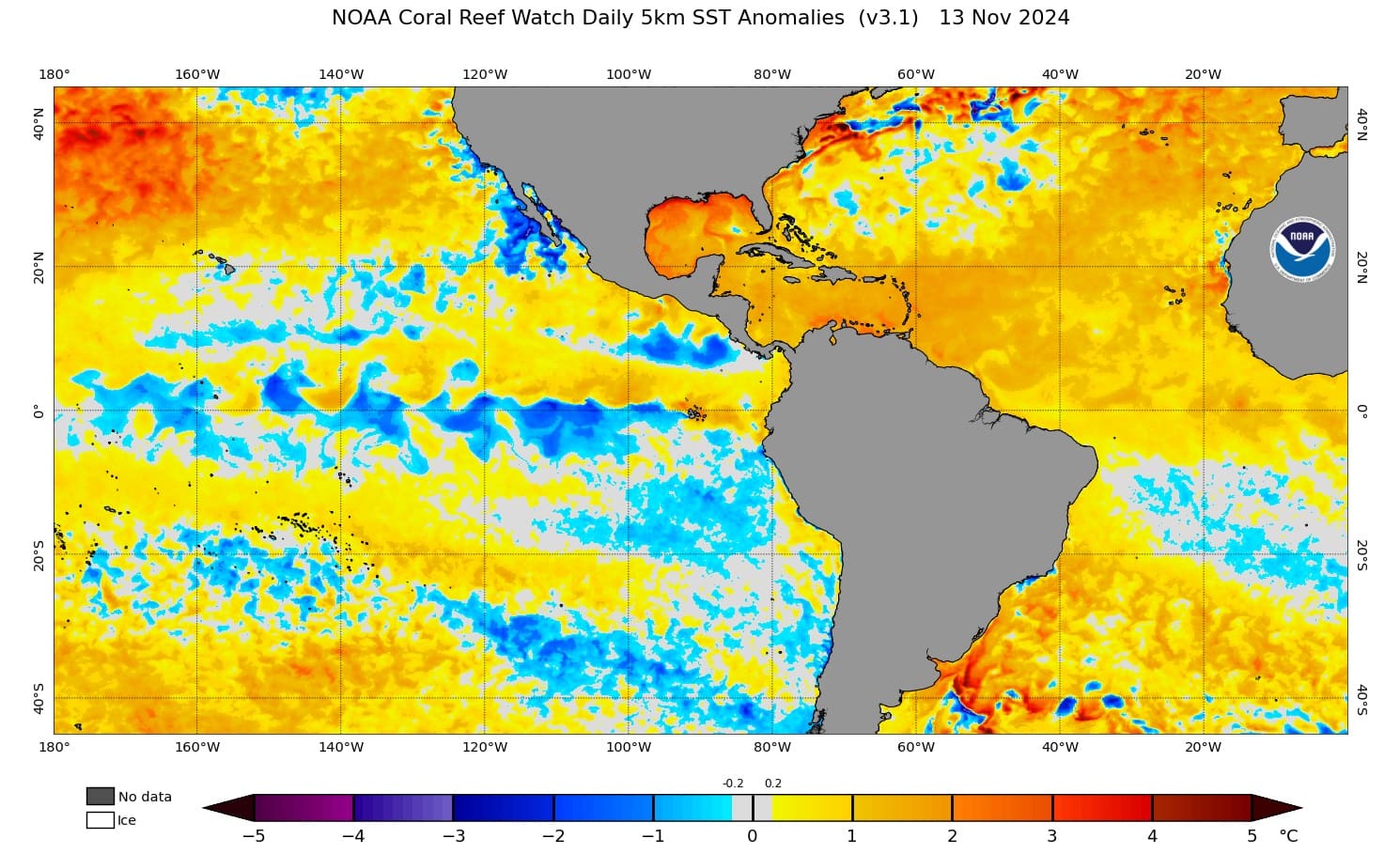The United States government’s weather and climate agency continues to believe in a La Niña episode, although there are growing doubts that such a phenomenon will be declared. Yesterday, the National Oceanic and Atmospheric Administration (NOAA) released its monthly update, indicating more than a 70% chance of La Niña at the beginning of 2025.

NOAA
According to the monthly update, for the October to December quarter, the probabilities are 57% for La Niña, 43% for neutrality, and 0% for El Niño. For the November 2024 to January 2025 quarter, NOAA indicates a 74% probability of La Niña, 26% for neutrality, and 0% for El Niño.
For the summer climatological quarter, from December to February, NOAA’s probabilities are 72% for La Niña, 28% for neutrality, and 0% for El Niño. In the January to March 2025 quarter, the estimates were 61% for La Niña, 38% for neutrality, and 1% for El Niño. From February to April, the forecast is 46% for La Niña, 52% for neutral conditions, and 2% for El Niño.
For the autumn climatological quarter of 2025, covering March to May, NOAA’s estimates are 33% for La Niña, 64% for neutrality, and 3% for El Niño. For the April to June 2025 quarter, the values are 26% for La Niña, 67% for neutrality, and 7% for El Niño.
Finally, in the May to July quarter of next year, the estimates are 23% for La Niña, 65% for neutrality, and 12% for El Niño. For the winter quarter of 2025, from June to August, NOAA’s estimate is 20% for La Niña, 60% for neutrality, and 20% for El Niño.
There was a marked change compared to the October bulletin in the probabilities for this last quarter of the year. Last month, NOAA estimated a 71% probability of La Niña for the current October to December quarter, which has now been reduced to 57%, increasing the neutrality estimate from 29% to 43%. However, it maintained a probability above 70% for La Niña in the summer quarter.
In its publication, NOAA highlights that “it is very late for La Niña to form.” The American agency notes that in its 75-year historical series for the Pacific, only two La Niña episodes have formed in the October to December quarter.
### Current Situation
Today, according to the latest bulletin from the National Oceanic and Atmospheric Administration (NOAA) of the United States, published earlier this week, the sea surface temperature anomaly in the Central-Eastern Equatorial Pacific (Niño 3.4 region) is at -0.3ºC.
This value falls within the neutrality range (-0.4ºC to +0.4ºC) after recording -0.2ºC in the previous week. Over the past four weeks, the average was -0.32ºC, which is below the minimum threshold of -0.5ºC required for declaring a La Niña event. In the last eight weeks, the average was -0.35ºC, thus solidly in neutral territory. If La Niña were to be declared—which we consider increasingly doubtful—the official beginning of the phenomenon would occur much later than usual, as events typically emerge in winter or early spring.
Moreover, the trend, according to our understanding at MetSul Meteorologia, is for the neutral phase of the Pacific Ocean to continue, at least in the short term. Although NOAA estimates a near 60% probability of La Niña in the short term, we at MetSul Meteorologia are not convinced of such a high likelihood.
We have long assessed that NOAA has been overestimating the probabilities of La Niña for months, and it was no surprise that in this month’s update, the La Niña probabilities were reduced for this last quarter.
What we foresee for the coming months points to two possible scenarios, and there are two because the conditions we expect are very borderline, in a range very close to the transition between the cold phase and neutrality, around -0.5ºC anomaly.
In the first scenario, increasingly less likely, an event develops now at the end of spring and the beginning of summer but would be very weak and brief, with the possibility of warming in the Eastern Pacific off the Peruvian coast, which would counteract the cooling effects in the Central Pacific.
In the second scenario, which we believe is increasingly probable, the Pacific remains in neutrality but with negative sea temperature anomalies close to La Niña values, borderline, but without characterizing a full-fledged event, which requires several quarters.
Even if the Americans at NOAA declare a La Niña event, it is highly likely that the Australians will not. This is because the minimum threshold for La Niña at the American agency (NOAA) is -0.5ºC, while for the Australian Bureau of Meteorology (BoM), it is -0.8ºC, which we do not believe will be reached on a quarterly average.




